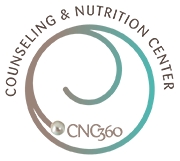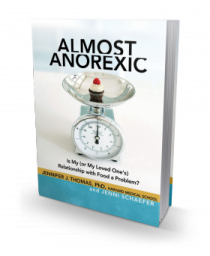by Natalie Gornstein, LICSW
Almost Anorexic is a recently published book by Jennifer Thomas, Ph.D. and Jenni Schaeffer that discusses the very prevalent sub clinical eating disorders that exist in our culture today. This book addresses the grey zone of eating disorders, what lies between “normal eating “ and a fully diagnosed eating disorder. Almost Anorexic caught my attention as it speaks to those who say they are not “sick enough” to have an eating disorder. Perhaps they meet only a few of the diagnostic criteria but their concern about weight and shape clearly has an impact of their lives. This book does a wonderful job of merging clinically sound, scientifically based information, case vignettes and personal recovery stories. Part I of the book talks about symptoms of “almost anorexia” and Part II outlines strategies for treatment.
The best way to describe “almost anorexia” is to think of people with eating disorder symptoms occurring on a continuum. On one end are people with normal eating or no concern about weight or shape. On the other end are people who are diagnosed with anorexia nervosa and other eating disorders. In the middle of the continuum are those who meet some but not all diagnostic criteria for anorexia nervosa, bulimia nervosa or binge eating disorder. This middle section covers those who are obsessed with their body image, engage in frequent crash dieting, or exercise obsessively. One does not need to be underweight or suffering from medical consequences of starvation in order to justify seeking help.
This well written book gives us the message that hating our bodies is not “normal.” A healthy life does not need to include stepping on the scale each morning and allowing the number to determine mood, exercising when sick or hurt, or restricting our food to fit into the clothes in our closet. Seeking therapy to rid ourselves of these food and/or body thoughts is not only justified, it is recommended. Living a life free of obsessions about food, weight and body is possible!
Thomas and Schaeffer outline specific strategies to begin the recovery process. They suggest starting with Phase I or “external cues” to help regulate eating. This includes setting up some kind of eating structure, identifying food rules and practicing self soothing skills to help manage feelings. These steps, along with many others outlined in the book should be taken before moving on to the next phase. Phase II focuses on more “internal cues” to guide eating with the ultimate goal of being able to eat intuitively. The book also addresses moving toward healthier exercise and learning to accept (and even love!) your body. Strategies for how to help a loved one who may be suffering from “almost anorexia” also are provided. Finally, Thomas and Schaeffer also address the importance of not settling for “almost recovered.” (For more on this see Beth Mayer’s post on Full Recovery).
In Almost Anorexic, the bottom line is that you or your loved one’s symptoms do not need to fall neatly into the category of one eating disorder or the other in order to seek help. If thoughts about food, weight and body are consuming your life, it’s time to get some support. As Thomas and Schaeffer write: “When food and weight begin to consume your life, joy is often what gets cut out to make room for all of that obsessing” (p. 39). You (or your loved one) deserve a life free from concern about food and weight. Chances are you have better things to think about!
Thomas, J. and Schaefer, J. (2013). Almost Anorexic: Is My (or My Loved One’s) Relationship with Food a Problem? (The Almost Effect). Cambridge, MA: Harvard University.

